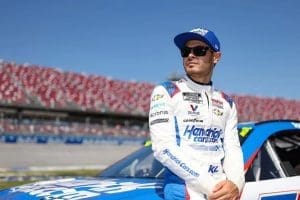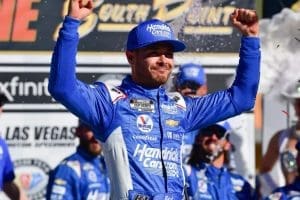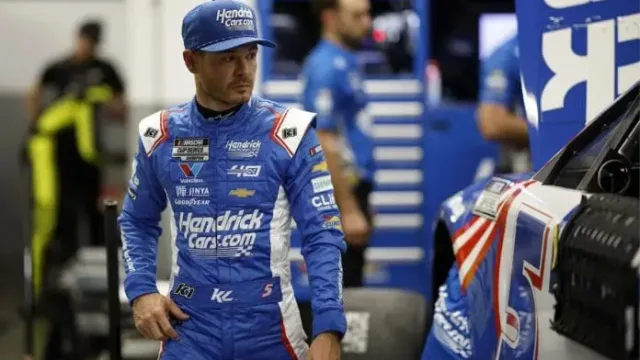Kyle Larson Talks Chevy’s NASCAR Struggles: Kyle Larson recently opened up about Chevrolet’s persistent struggles at New Hampshire Motor Speedway, pinpointing car balance as a critical issue. Despite the challenges, Larson’s history of top-10 finishes at the track underscores his adaptability and strategic brilliance. His candid assessment reveals the delicate dance of maneuvering evolving NASCAR regulations while aiming for consistency. As the playoffs loom, Larson’s determination to overcome these obstacles could be crucial for Chevy’s general performance. What specific changes might Larson and his team implement to turn the tide at this notoriously tricky venue?
Key Takeaways
- Larson highlights Chevy’s historical balance issues at New Hampshire, impacting performance.
- Emphasizes the importance of fine-tuning suspension, aerodynamics, and tire management for car balance.
- Notes Chevrolet’s ongoing efforts and progress in improving their short track program.
- Mentions his own consistent top-10 finishes despite Chevy’s struggles at New Hampshire.
- Discusses the critical role of data analysis and pit strategy in achieving competitive performance.
Chevrolet’s Performance at New Hampshire
Chevrolet’s performance at New Hampshire Motor Speedway has been marred by persistent car balance issues, a challenge that Kyle Larson of Hendrick Motorsports has candidly acknowledged. The 1.058-mile oval, with its unique and variable banking, demands a well-balanced car to navigate its tight turns and short straights effectively. Chevrolet, despite its storied presence in NASCAR, has found this track particularly taxing. Larson’s insights illuminate the intricate struggles faced by the manufacturer, elucidating why victories at New Hampshire have been elusive.
The heart of Chevrolet’s difficulties lies in achieving essential car balance, a factor critical at New Hampshire where the difference between success and mediocrity is razor-thin. The track’s variable banking requires a delicate setup that can adapt to different sections of the course, an area where Chevrolet has historically lagged behind competitors. Larson’s analysis underscores the importance of fine-tuning suspension settings, aerodynamic tweaks, and tire management to improve stability and grip, key components that have been inconsistent for Chevrolet teams at this venue.
The evolution of NASCAR’s regulations and the introduction of newer car models have periodically shifted performance dynamics, yet Chevrolet’s quest for consistency at New Hampshire remains a work in progress. Larson highlights that despite ongoing advancements, the team continues to wrestle with the nuances of car balance, aiming for the precision needed to conquer the track. His candid reflections not only bring to light the technical challenges but also underscore the relentless pursuit of excellence that defines Hendrick Motorsports and Chevrolet’s enduring legacy in NASCAR.

Larson’s Track Record at NHMS
Kyle Larson’s own experiences at New Hampshire Motor Speedway echo the broader struggles of Chevrolet, marked by several commendable top-10 finishes but an elusive victory despite coming tantalizingly close with runner-up finishes in both the 2014 Sylvania 300 and the 2017 New Hampshire 301. These near-victories, achieved while driving for Chip Ganassi Racing, show Larson’s skill and resilience on the track, even as he faced the same challenges that have plagued Chevrolet as a whole.
“It’s just balance probably. I wouldn’t say luck, just balance of your race car I think. You know Gibbs here lately, and then Penske a while back kind of had a string hold on this place.”-(kyle)
Larson’s path at New Hampshire has been a mix of promise and frustration. His consistent presence in the top-10 highlights a deep understanding of the one-mile oval’s intricacies. Each race has seen Larson deftly maneuver through the field, displaying a blend of aggression and patience that marks the driving style of a seasoned competitor. However, the final push to the checkered flag has remained just out of reach, a confirmation of the fine margins that separate victory from near-miss in NASCAR.
In the 2014 Sylvania 300, Larson’s runner-up finish was a breakthrough moment, signaling his potential to contend with the sport’s elite. Three years later, his performance in the 2017 New Hampshire 301 reaffirmed his prowess, but also mirrored the recurring theme of coming close but not quite clinching the win. These performances, while falling short of victory, have solidified Larson’s reputation as a formidable driver at New Hampshire.
Larson’s track record at New Hampshire mirrors the challenges faced by Chevrolet, illustrating both the potential and the persistent hurdles. His experiences offer a microcosm of the broader narrative, embodying the spirit of perseverance and the pursuit of excellence despite the odds.
Assessment of Car Performance
The performance of the Chevrolet cars at New Hampshire Motor Speedway has been a central focus of analysis, as teams work to find the right balance and setup to compete with dominant forces like Gibbs and Penske. In a sport where fractions of a moment can determine race outcomes, achieving the ideal car balance is paramount, according to Kyle Larson, who downplays luck in favor of meticulous engineering and strategic adjustments.
“I feel like our short track program has gotten better though I think you know last year I kind of ran around fourth to sixth the whole race so um yeah I mean we’re getting better just got to keep working.”-(kyle)
Larson highlighted several key areas where Chevrolet teams have concentrated their efforts to improve performance on the 1.058-mile track:
- Car Balance: Larson emphasized that achieving a well-balanced car is critical. This involves fine-tuning aspects such as weight distribution, suspension settings, and aerodynamics to make sure that the car performs well in both corners and straights.
- Short Track Program: Over the past seasons, Chevrolet has made significant strides in its short track program. Larson noted that while Gibbs and Penske have set a high benchmark, Chevrolet’s progress suggests a potential shift in competitive dynamics.
- Data Analysis: Advanced data analytics play a vital role in refining car setups. Teams utilize telemetry and simulation tools to analyze previous races, understand tire wear patterns, and predict car behavior under different conditions.
- Pit Strategy: Beyond car mechanics, race strategy, particularly pit stops, has been a focal point. Efficient pit stops and smart tire management can make a substantial difference in maintaining track position and gaining an edge over competitors.
The ongoing efforts by Chevrolet teams to improve their performance at New Hampshire Motor Speedway reflect a broader commitment to excellence and competitiveness in NASCAR. As Larson and his team continue to refine their approach, the results on the track will be a proof of their relentless pursuit of perfection.

Expectations for Current Race
Larson’s optimism is rooted in Hendrick Motorsports’ proven ability to adapt and excel under varying conditions. Despite the setback of starting from the 19th position due to the cancellation of qualifying sessions, Larson remains confident in his team’s potential to rise through the ranks. His confidence is well-founded, stemming from Hendrick Motorsports’ history of strong performances and their knack for making important adjustments that capitalize on race-day opportunities.
“I would have loved to gotten some practice just because this is a place that we haven’t had a ton of speed at but yeah we’ve unloaded well at every racetrack for the last couple season. So, I’m confident that we’ll still have good speed and a good balance to start the race and hopefully be able to drive towards the front.”-(larson)
Larson’s faith in the team’s capabilities is bolstered by their consistent speed and balance shown earlier in the season. Such attributes are critical at New Hampshire Motor Speedway, a track known for its flat turns and demanding grip levels. The technical prowess of Larson’s crew in fine-tuning the car’s setup to meet the track’s unique challenges could be the decisive factor in moving up the grid. Additionally, the strategic acumen of the team, combined with Larson’s driving skill, sets the stage for a potential top-tier finish despite the initial disadvantage.
The dynamic nature of NASCAR races, where variables such as weather, pit strategy, and in-race adjustments play pivotal roles, aligns with Hendrick Motorsports’ strengths. Larson’s confidence isn’t mere bravado but a reflection of a well-oiled machine poised to capitalize on any unfolding scenario.
Playoff Outlook and Current NASCAR Standings
As the race at New Hampshire looms, Larson’s focus inevitably shifts towards the broader implications for his playoff outlook and current standings within the NASCAR Cup Series. With three wins and eight stage victories, Larson and the Hendrick Motorsports (HMS) team are well-positioned to maintain momentum heading into the playoffs. However, the recent standings shuffle—where Chase Elliott overtook Larson following the Iowa race—adds an extra layer of competitiveness within the team.
Larson remains optimistic about HMS’s capabilities, despite Chevrolet’s struggles at certain tracks. His confidence is buoyed by the team’s consistent performance and strategic prowess, both of which are critical as the playoff picture becomes more defined. The upcoming race at New Hampshire represents not just another opportunity to secure stage points but also a chance to solidify his position among the top contenders.

Key factors to watch as Larson navigates the remainder of the season include:
- Consistency in Performance: Regularly finishing in the top 10 will be important for Larson to accumulate the points needed to advance in the playoffs.
- Team Dynamics: The internal rivalry with teammates like Chase Elliott could either spur greater performance or cause friction, depending on how it is managed.
- Track-Specific Challenges: Understanding and adapting to the unique characteristics of each track, particularly those where Chevrolet has historically struggled, will be crucial.
- Stage Wins and Playoff Points: Accumulating stage wins and playoff points can provide a buffer against potential setbacks in later races.
News In Brief: Kyle Larson Talks Chevy’s NASCAR Struggles
Chevrolet’s historical difficulties at New Hampshire necessitate a keen focus on addressing car balance issues to boost performance.
Kyle Larson’s consistent top-10 finishes underscore the significance of continuous improvement and adaptation to evolving regulations.
The current race presents an opportunity to assess car performance and adjust strategies accordingly.
As the playoffs approach, Larson’s determination and insights will be vital in driving Chevrolet towards greater consistency and success, ultimately shaping the team’s competitive trajectory in NASCAR.
ALSO READ : Martin Truex Jr’s Cabo Adventure: Sleepless Nights and NASCAR Antics
